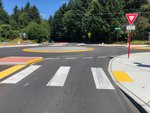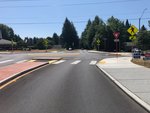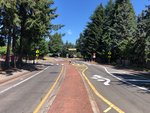



OLYMPIA –– If you drive down Henderson Boulevard regularly, you probably noticed a traffic circle that sprang up at the intersection of Henderson and Eskridge. Interestingly, it appears to be offset – drivers noticed they must curve around the roundabout when traveling north, but southbound traffic seems to be able to coast straight through.
What’s the background to the construction of this traffic circle? Why was it placed? How much did it cost? And, as many asked –– why is it not centered?
According to Andrew Beagle, Transportation Engineering Supervisor for Olympia Public Works, city officials saw the Henderson and Eskridge intersection as a location that needed a unique solution to make it functional. Cars could be backed up and cause delay on the road with a conventional roundabout, and city officials also designed the roundabout to make it safe for pedestrians and cyclists.
“We looked at a couple of options,” Beagle said. “One was the roundabout and the other was a signal system.”
The result was a compact roundabout, a decade-old roundabout design. Other roundabout types, such as the one on Boulevard Road, have been around longer for a lot longer nationwide. These roundabouts are still relatively new to Olympia. Henderson and Eskridge is the first compact roundabout in the area.
One of the benefits to the compact roundabout design, said Beagle, is the lower cost.The larger Boulevard roundabout cost $5 million, while the compact roundabout at Henderson and Eskridge cost $1 million, or a fifth of the cost. Building the most expensive types of roundabouts could result in delayed construction and cause a lag in development in the area, and the compact version can be implemented more quickly.
“The issue we encountered with the center feature and it being somewhat offset mostly has to relate with where the underground utilities are located,” Beagle said. “Part of the way to keep a compact roundabout cheaper is to not tear as much up. We try to avoid having it escalate into much more expensive work, and underground work is part of that.”
The lower cost is important for another reason, as one of the issues with funding has been the passage of Washington Initiative 976 in 2019, which aimed to lower vehicle registration fees and taxes with a $30 cap for most vehicles. As Olympia Public Works waits for clarification on how I-976 will be implemented, there are funds that are in limbo, and the department is looking at reduced funding. The potentially reduced amount of funding will require the department to steward its financial resources. As Beagle notes, the relatively less expensive design also means that it can be more rapidly implemented. With limited transportation dollars, this is one way to help spread out the funding to benefit the community.
One tradeoff with the reduced cost of a compact roundabout, however, is that its placement is somewhat limited by the location of underground utilities. Because the compact roundabout involves less digging and demolition, it necessarily also has to work with existing infrastructure to avoid escalating the costs of construction. Beagle said during the Henderson and Eskridge roundabout construction, a manhole entrance was located that was going to be in the way of construction. The roundabout’s location was shifted a bit, thus the reason for it being slightly off-center relative to Henderson Boulevard, and allowing southbound traffic to potentially travel through the roundabout in a straight line instead of having to curve around the circle. Theoretically, that shouldn’t present a concern, as Henderson Boulevard has a set speed limit of 25 miles per hour.
Beagle says there are some safety tips he’d like folks to be aware of. For starters, a compact roundabout is necessarily a tighter circle. This means that as drivers are approaching the roundabout, they’ll have less time and distance to determine their gap acceptance – the opportunity to enter the intersection –– and should be aware of this dynamic, and pay attention to signs instructing them to yield appropriately. The department also took into account other factors such as pedestrian safety and installing rectangular rapid flashing beacons to alert drivers when pedestrians are crossing. They also made other minor changes based on feedback from users, and continue to monitor traffic use at the roundabout.
The department wants to understand how to continue to improve on design and implementation as they move forward, because these compact roundabouts are looking like a promising benefit to the system. Given the limitations of the budget, these designs represent an excellent and cost-effective approach to improving traffic design in the city. As the city identifies major needs based on their metrics, it determines what it can afford in the way of improvements in order to facilitate growth and development in transportation.
“All these things are helping us learn and perfect that design, and hopefully we're going to see more of these,” Beagle said. “It's one of the rapid actions we can take that's going to help us spread the transportation money we have across the system.”
One last little tidbit of information – if you’re wondering about the very small traffic circle that was recently installed across from Olympia High School at Henderson and Carlyon, Beagle states that it was implemented as a required retrofit as part of the expansion of the high school.
Daniel Hu is a freelance writer for JOLT.
This story has been corrected to state the small traffic circle near Olympia High School was a required retrofit of the high school itself, not the greater Olympia School District.
Comments
No comments on this item Please log in to comment by clicking here